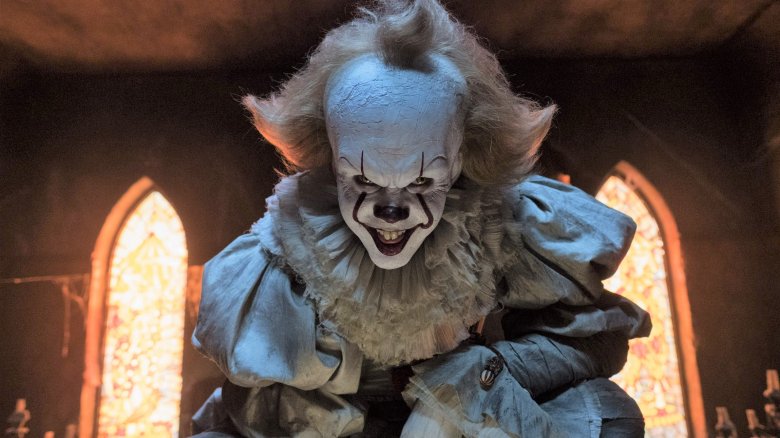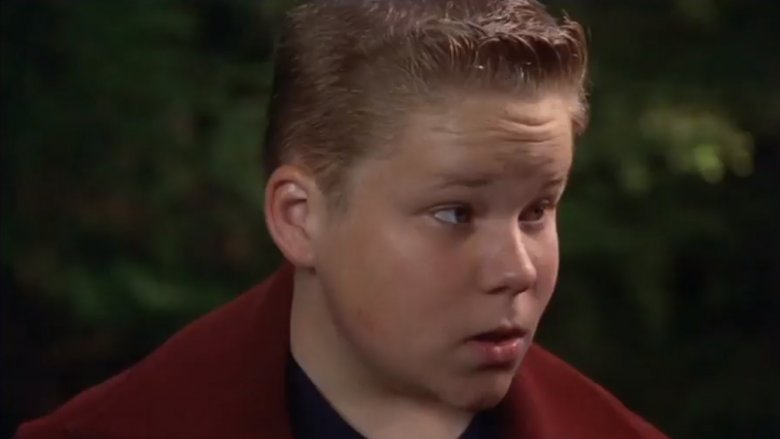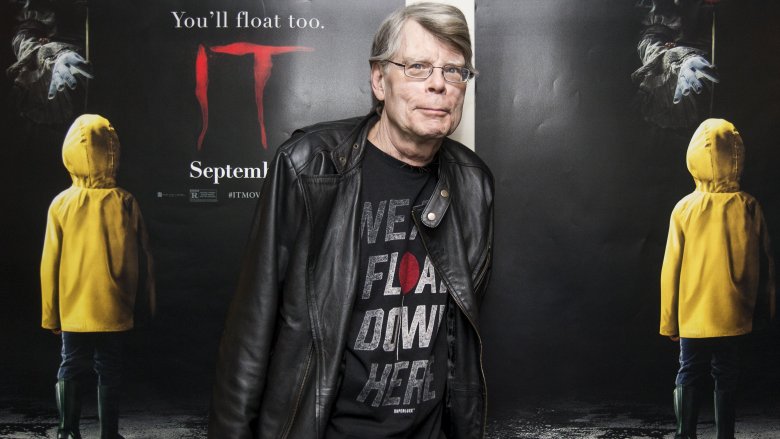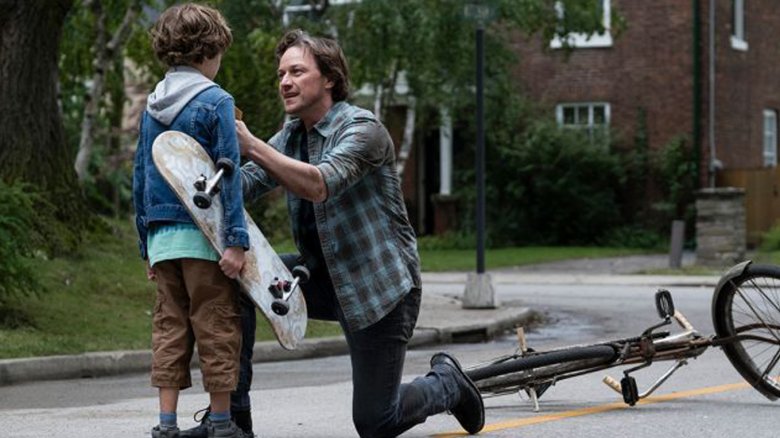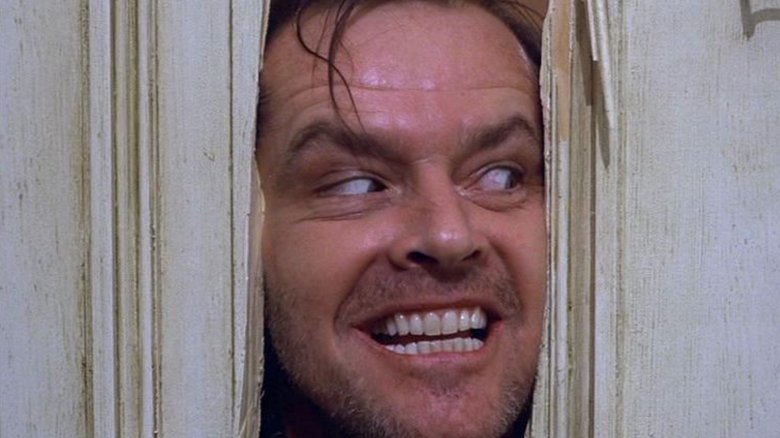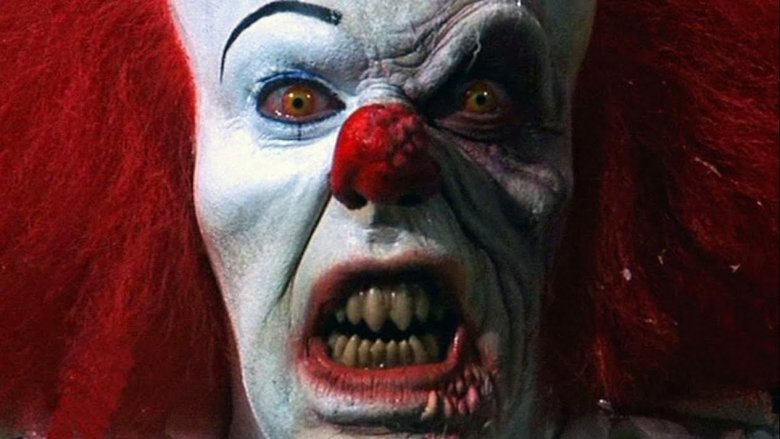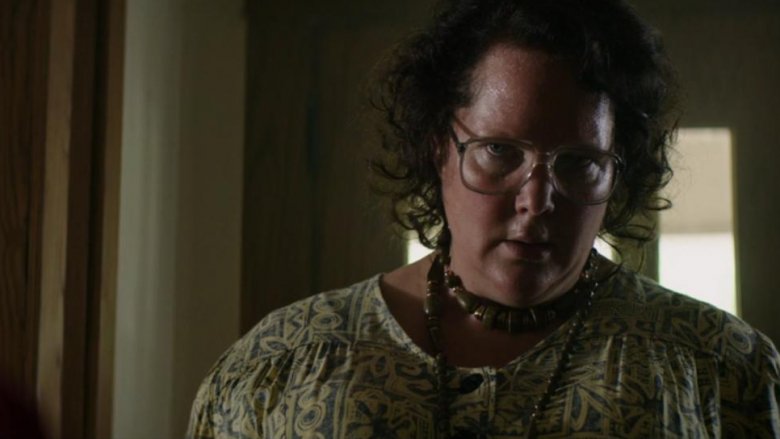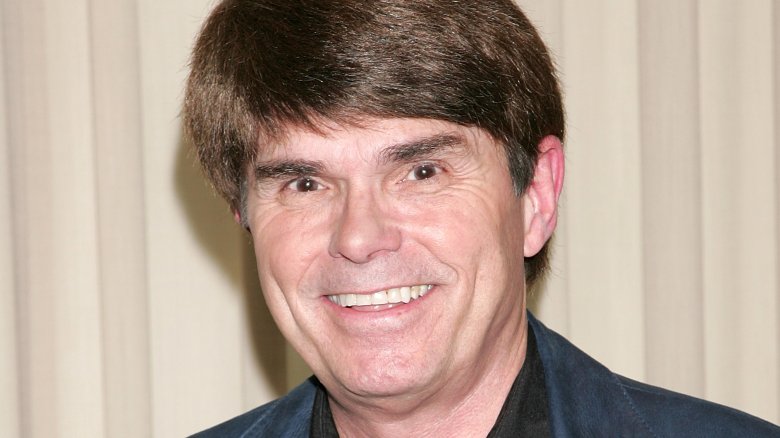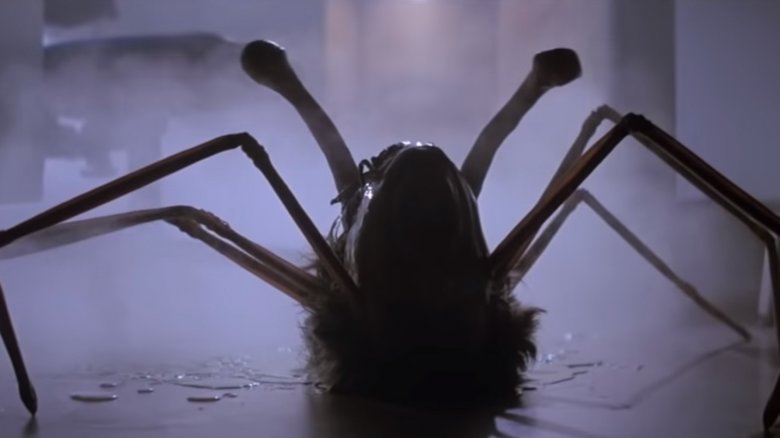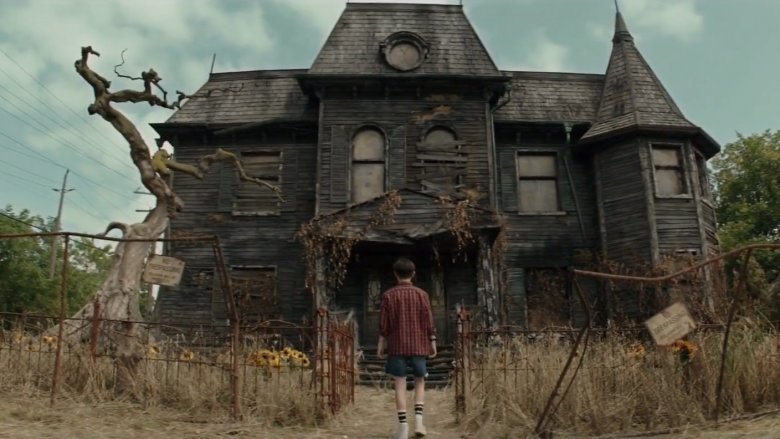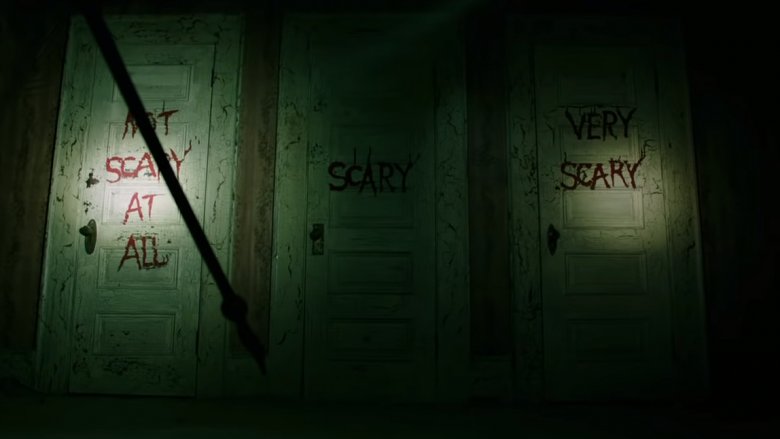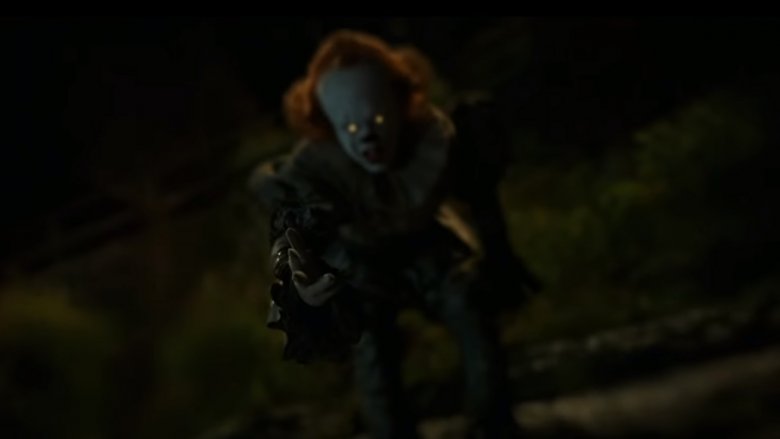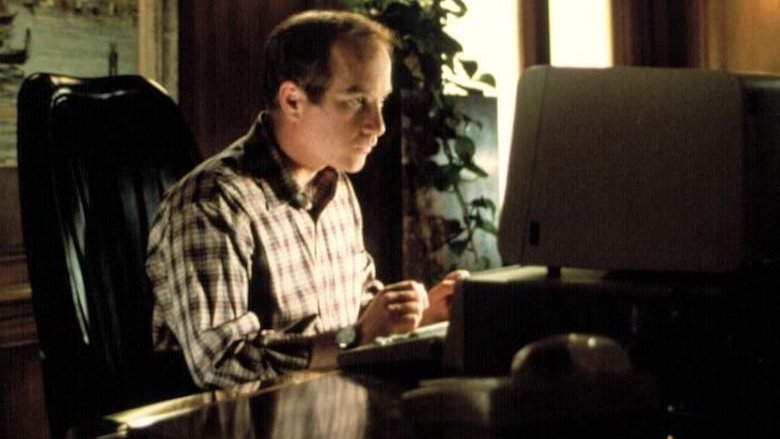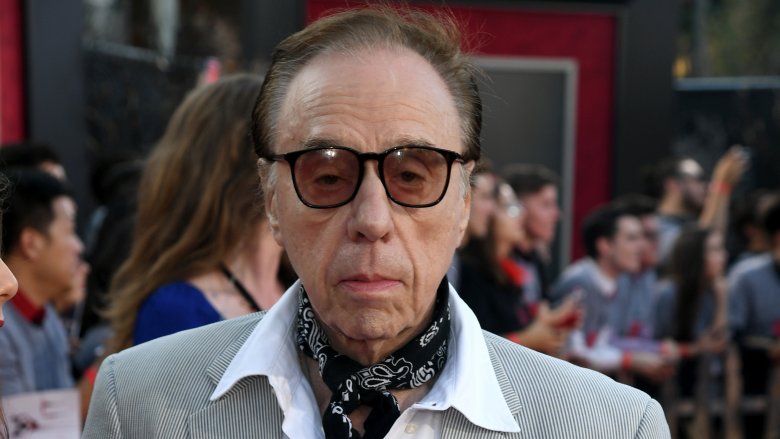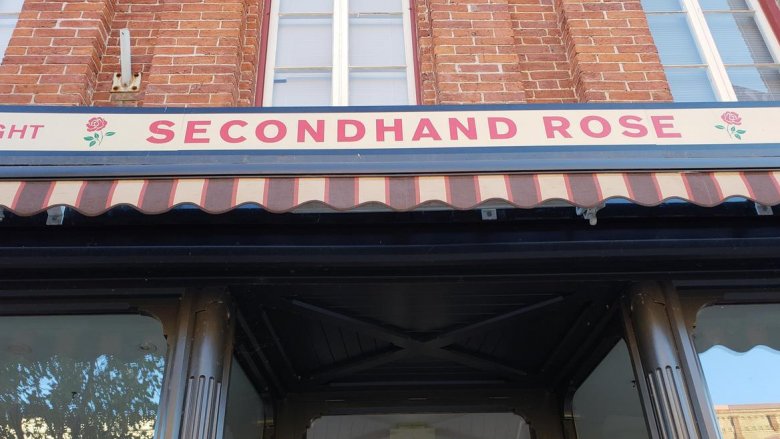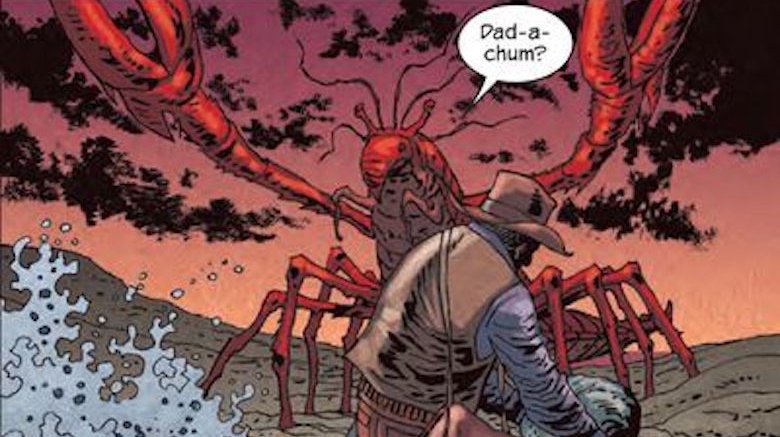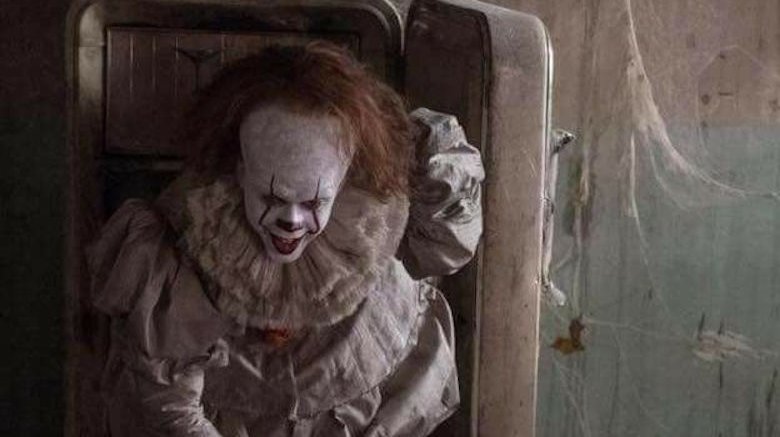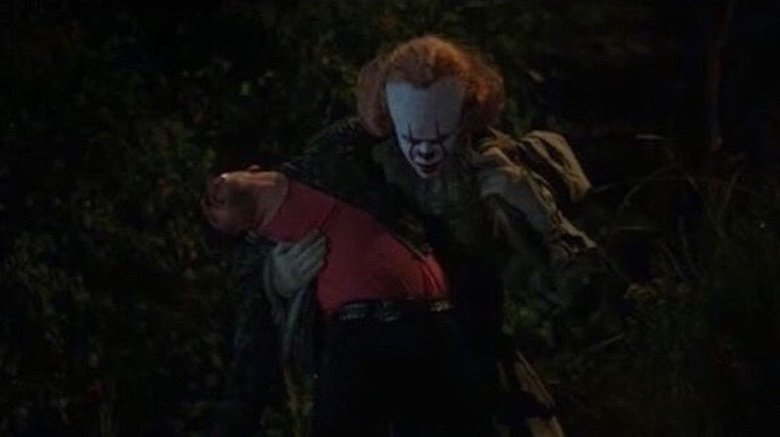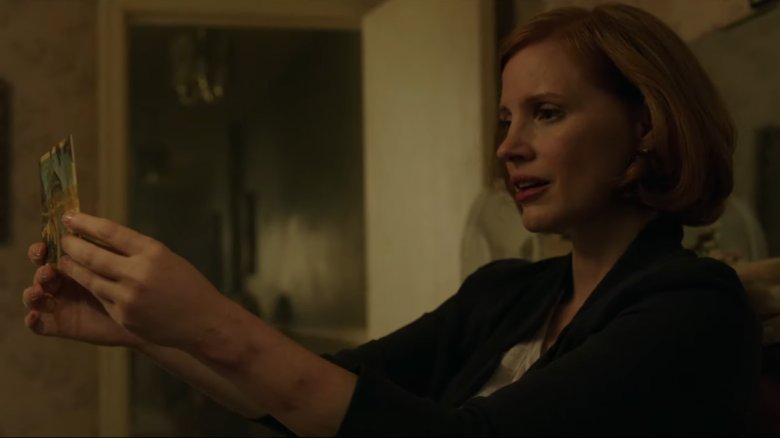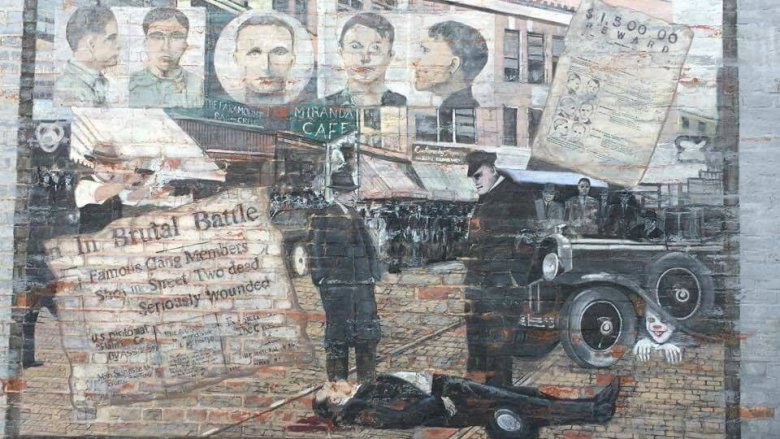Easter Eggs You Missed In It: Chapter Two
It: Chapter Two has finally pranced into theaters, bringing to a close the long, bloody saga of Derry, Pennywise, and the Losers Club. After driving "It" away in the first film, the Losers are called back home to deal with the reemergence of their childhood enemy. Now adults, they'll need to remember the special bond they shared as kids if they're going to stand a chance against the shapeshifting face of evil.
But don't think we're leaving the circus quite yet. With a runtime of nearly three hours and a book with over 1,000 pages to reference, there were bound to be plenty of Easter eggs in It: Chapter Two, and the film definitely delivers on that.
So float on down. We're going deep into the sewers to dig up all the Easter eggs and references you might've missed in It: Chapter Two. Now is your last chance to turn back, because there are plenty of spoilers ahead.
Always a Loser
It: Chapter Two has a lot of catching up to do. While the first film focuses exclusively on the kids, this one has the dual job of both introducing the adult versions of the Losers and making you believe that they really could be those children all grown up. Most of these introductory scenes open on the character in question, framing them by the phone calls they get from Mike. But there is one fake out, and it features a pretty cool cameo.
When we're introduced to adult Ben Hanscom, we see a board room with a bunch of men arguing over the model of a building. Constant Readers were ready for this, of course, knowing that Ben Hanscom grows up to be a famous architect. And while he doesn't down a beer mug full of whiskey and shoot lemons in his eyes, we all figured we were meeting Big Ben as soon as we heard people discussing the design of a new building. That's what architects do all day.
After the camera slides over the room, it finally focuses on one man who seems to know a lot about the building in question. It's Ben! Except, as it turns out, it's not. Ben, as portrayed by Jay Ryan, is on a Skype call with everybody in that room. But it's a double fake-out, because that first guy was Ben all grown up. Confused yet? Hold on. See, that actor was Brandon Crane, who played Ben Hanscom in the 1990 miniseries. In a film all about childhood, loss of childhood, and facing the fears of your childhood, bringing an actor in who's been both a child and an adult in an adaptation of It is basically icing on the cake.
The King of cameos
There was one special cameo that fans of Stephen King probably noticed, but which might've flown over the heads of casual viewers. No, not the one where director Andy Muschietti is extremely interested in a bottle of Mucinex when Eddie visits the Derry pharmacy. We're talking, of course, about King himself.
The horror auteur and author of such classic books as It shows up as the owner of Secondhand Rose, the thrift store where Bill finds his childhood bike, Silver. Like King's portrayal in the film, the proprietor in the novel is kind of an a-hole, and he's reading, quote, "a paperback novel which Bill thought had never been nominated for the Pulitzer Prize."
In the film, of course, the shopkeeper has a copy of Bill's book, Attic Room, on his desk, so we're guessing that's doubling down on the joke that Bill may be a famous writer, but he's kind of a hack. Or at least he's never won a Pulitzer Prize.
But don't the best jokes always come in threes? After Bill notices the book, King cocks an eye at him and says that he didn't like the ending. Because ... get it? So many people don't like the ending of King's books? Like the joke that was repeated 18 times throughout the movie? This whole scene is basically a week-long road paver's convention. It has layers for days.
It: Chapter Two and a mysterious turtle
Turtles! Aren't they great? They're reptiles, they have cool body armor, they love pizza, and they're ancient intergalactic beings who occasionally regurgitate galaxies when they aren't feeling too well.
Wait, what?
Okay, so for that last part, we're talking specifically about Maturin, the ancient intergalactic turtle in the It novel that sort of, almost helps the Losers defeat It during round one of their face-off. In the climactic scene in the kids' timeline, Bill performs the Ritual of Chud with Pennywise and ends up soaring through a cosmic realm beyond space and time, at which point he encounters a big ol' turtle. Maturin comes from the same dimension as the being known as It, and in fact, he created our world by puking it out when he had indigestion. Thank god the Macroverse doesn't have Pepto Bismol, or we'd never be here talking about a movie based on a book in which a turtle pukes out our universe and ... you know what? Let's move on.
While neither of the It films have dared to quite go into that level of cosmic WTF-ery, they've definitely dropped a few turtle Easter eggs. For example, It: Chapter One puts a Lego turtle in Georgie's room (56:27), as well as a mention of a turtle at the quarry where the kids go swimming. And in Chapter Two, we see a model of a turtle at Derry Elementary when Ben revisits the school to find his token.
While these could just be Easter eggs, we have to wonder, are they also a subtle nod to the fact that Maturin is also influencing events in Derry? Just as Pennywise likes to stick the word "It" in random places, like the You've Got Mail poster in the arcade Richie visits, is Maturin also using his super-duper eldritch god powers to put images of himself in the background? Man, it must get boring being eternal.
You can't shine on a skateboard
In an effort to double down on Bill's guilt at not being able to save his little brother, Chapter Two also brings in Dean, known in the novel as "some kid," to die right in front of Bill despite his best efforts to save him.
The kid shows up three times in the film, but in the novel, he only appears once, when Bill is wandering around Derry and revisits the old sewer opening where Georgie became Pennywise's lunch. The scene plays out in the book pretty much the same way it does in the movie. Bill notices the kid with his skateboard and urges him to stay away from the sewers because there are killer clowns afoot. As they part, Bill tells the boy to be careful, to be met with the response, "You can't be careful on a skateboard.
In the movie, though, we get an additional detail referencing one of King's other works, The Shining. If you pay close attention to the underside of Dean's skateboard, you can see that, although it's a little roughed up, it once had the same design as the Overlook Hotel's carpet in Stanley Kubrick's adaptation of The Shining. Apparently, Andy Muschietti reacted to Stephen King's attempt to bring that novel to life the same way we all did — by completely ignoring it.
Don't overlook this classic horror Easter egg
When the adult Losers finally track Pennywise down to its underground lair and totally flub the Ritual of Chud, the clown gets them all to scatter. One by one, they all relive a twisted, surreal version of their childhood fears. Beverly's nightmare takes the form of a stall in a school bathroom, one that looks a lot like the one where she got trash dumped on her in the beginning of the first film. To her, the stall clearly symbolizes some sort of cage, because her tormentors from over the years begin trying to burst through the door to taunt her.
They all have something relevant to say except crazy Henry Bowers, who jams his head into the gap and shouts, "Here's Johnny!" You know, just like a certain other crazed maniac in a certain other Stephen King adaptation.
It: Chapter Two pays homage to the miniseries
Tim Curry's rendition of Pennywise in the 1990 miniseries sent many a kid to bed with nightmares of toothy clowns coming out of the locker room drain. Yeah, it's a little goofy these days, but what can you do with all the special effects budget provided by network cable?
But while it's not the most fondly remembered Stephen King adaptation, the 1990 version of It definitely has its own place in history. For roundabouts 27 years, Tim Curry was the definitive creepy clown until a new version crawled from the sewers beneath Remakeland, and no modern adaptation worth its salted kid meat is going to ignore the miniseries completely. In It: Chapter One, we get a Tim Curry Pennywise doll in the scene where Richie comes across a bunch of clown dolls in the house on Neibolt Street. But in the sequel, we get an even bigger revival of the miniseries.
For starters, one of the most iconic lines makes a return in the 2019 film. It's not particularly PC, but it's still good for a chuckle. During the flashback of young Ben Hanscom hiding from It in his locker (after trying to kiss Beverly), Pennywise appears and growls, "Kiss me, fat boy." If you watch the 1990 version today — with clear, adult eyes — as a comedy, it's probably the best line in the whole thing.
After (or before) that (it's hard to tell with all the flashbacks in the second act), Bill chases a young boy into a clown-themed funhouse at the Derry Canal Days Festival, intent on saving him. One of the first obstacles Bill encounters is a row of swinging clown bags. Look closely, and you can see that those clowns have the same pattern as the outfit from Curry's Pennywise, right down to the orange pom poms and curvalicious eyebrows.
Mom, wife, what's the difference?
Stephen King's novel spends multiple chapters hammering home the point that although the Losers grew up physically, they each carried remnants of their childhood into adulthood with them, like peeling skin that just won't flake off. In Eddie's case, he grows up into a man who can't quite bear to leave his mother behind. So he marries her.
Okay, not literally. But Eddie's wife, Myra, is physically, and sometimes spiritually, a doppelganger of his mother. She's largely built, often domineering, and engaged in her husband's welfare to the point of nearly emotionally traumatizing him. Just like mom! Way to go, Eds.
In It: Chapter Two, we only see Myra Kaspbrak briefly, but sharp-eyed viewers may have noticed a very, very specific detail. Namely, she's portrayed by the same actress who plays Eddie's mother in both films, Molly Atkinson. So if you got a weird little sour feeling in your stomach thinking that Eddie's wife looked a lot like his mom, you weren't wrong. Jeez. Oedipus called. He wants his literary themes back.
An Easter egg aimed right at Dean Koontz
If you had to name two mainstream horror authors from the past few decades, chances are you'd be quick to come up with two names: Stephen King and Dean Koontz. Both are prolific writers, and both have been writing published fiction for about the same length of time (Koontz since the late '60s, King since the early '70s).
So you also might think there's a rivalry that exists between the two authors. They both write in essentially the same genre, after all, and for a special time in the '80s, if you weren't reading a Koontz book, it's because you were reading a King book, and vice versa.
Obviously, the two authors have taken notice of each other over the years, and while they probably don't have the kind of rivalry fans like to think they do, they haven't been averse to taking shots at each other. Sometime between 1981 and 1985, King wrote Koontz into It as an orderly at Juniper Hill Asylum who watches over an incarcerated Henry Bowers. His name in the novel is John Koontz, and the scene involves an observation, as told from the perspective of Henry Bowers, that "Koontz is the worst."
In It: Chapter Two, John Koontz is alive and well, with an especially fitting appearance. As in the book, he's an employee at Juniper Hill, and he's realized in the film as the guard watching a dog video on his phone when Henry Bowers breaks out. That's a particularly savvy detail, since any Dean Koontz fan knows that the author loves his dogs.
It's kind of a Thing
In the book, the 1990 miniseries, and, to a lesser extent, It: Chapter One, It often takes the shape of movie monsters to terrify the kids. Ben Hanscom is scared of The Mummy, while Richie's fears take the form of the hairy shapeshifter from I Was a Teenage Werewolf and the oozing peeper from a 1958 creature feature called The Crawling Eye. Because who wouldn't be scared of that?
But with updated times come updated scares, and it appears these '80s kids have found some new monster movies to be scared of. Something like John Carpenter's 1982 horror masterpiece The Thing. For a refresher, The Thing is about a shapeshifting alien that plagues a research team in Antarctica. It can take the form of anything it infects, but it has to go through hideous transformations to get there. In one of It: Chapter Two's more memorable scares, Richie, Bill, and Eddie come across Stan's decapitated head in a fridge inside the house at 29 Neibolt Street. Almost immediately, the head grows a bunch of freaky spider legs and jumps on Richie's face. Just before that, however, Richie says, "You gotta be f—-ing kidding me."
It's a fitting tribute to the scene in Carpenter's horror fest, which sees one of the researchers, Vance Norris, lose his head to the tentacled monstrosity, at which point the character of Palmer says, you guessed it, "You gotta be f—-ing kidding me."
Later, The Thing gets called on once again when that adorable Pomeranian behind the "Not Scary" door morphs into a twisted, corpsy dog mutant — a fairly similar look to the dog that gets infected in John Carpenter's horror classic.
The ending of It: Chapter Two is a slight nod to the novel
A major theme in the novel is the way that It is essentially the entire town of Derry, Maine. It's not just part of the town, it is the town. As we saw in Bill's vision, It arrived on Earth from space millions of years in the past, and it's been chilling in that same spot ever since. When a bunch of loggers built up Derry, It finally got its free lunch — all the people it could eat, for less than the cost of a tray at Golden Corral. As Derry grew, It essentially worked beneath all the gears to make sure nobody noticed its presence. Sure, a bunch of kids go missing roughly every three decades, and sure, there's a major disaster to end every cycle, but as long as all the adults look in the other direction, It doesn't have any problems.
The Losers obviously screw all that up, and when they finally defeat It, they actually end up, in a way, defeating all of Derry. With Its death, most of downtown Derry dies with it, collapsing into the tunnels that crisscross beneath the town. At least, that's how things go down in the novel. Unfortunately, It: Chapter Two doesn't go in that direction, but we still get a taste of what would've happened. After they squish Pennywise's heart, the remaining Losers run out of the house at 29 Neibolt Street, then turn around to see it sink straight into the ground before ultimately collapsing to rubble.
It's a small taste of what happens to the entire town in the book, but a small nod to that cataclysmic destruction is better than nothing. We guess the only time we'll see the Derry Standpipe get wiped out in apocalyptic fashion is when Ben accidentally drops his little paper model in the first film. Eat your heart out, Spielberg?
It: Chapter Two's leggy Easter egg
Probably the creepiest sequence in the 2017 film is when the kids go exploring in the house on Neibolt street and run into a variety of clown-flavored horror spectacles. Certainly the most memorable segment from that sees Richie and Bill faced with the "scary doors."
Labeled "Very Scary," "Scary," and "Not Scary At All," the doors present the boys with a psychological riddle. Thinking on their feet, they first run to the door labeled "Not Scary At All," and find that, surprise, it's pretty scary. Inside, they see one of the missing girls, Betty Ripsom, hanging by her hands with everything below her waist missing. The boys stumble back, and Richie exclaims, "Where the f— are her legs?"
Well, it takes 27 years, but Richie eventually finds them. When they're back in 29 Neibolt as adults, Richie again comes up against the three scary doors, and the first one he opens reveals a pair of torso-less legs staggering towards him.
The number 27 abounds
While It: Chapter Two is full of Easter eggs, there's one that isn't technically in the movie. Technically, this egg breaks through the universe of the film and into our world, which is even creepier. Okay, so it's not that creepy, but it's still pretty cool. Most King fans know that he's big on the number 27, and It in particular uses the number as a main plot point, as Pennywise comes back every 27 years. It makes sense then that It: Chapter Two saw a release date of September 6, 2019. If you break 6/6/2019 down number by number, you get 9+6+2+0+1+9 = 27.
That's not a coincidence, either. It: Chapter One, released, on September 8, 2017, follows the same formula: 9+8+2+0+1+7 = 27. Add to that the fact that the first film was released 27 years after the 1990 miniseries, and, well, things are starting to get a little freaky here.
Poignant references to Stand By Me
Stephen King's stories are often connected through their New England locations as well as their monsters. It takes place in Derry, Maine, and the book often references the nearby town of Castle Rock, where King's novella "The Body" and its movie adaptation, Stand By Me, take place. These two stories are also connected through their focus on friendship, childhood trauma, and the end of innocence as groups of kids are forced to confront dark forces around them, both supernatural and human.
At the end of Stand By Me, Gordie LaChance (Richard Dreyfuss) is finishing the last lines of his memoir, inspired by the news of his childhood best friend's death. His office has dark wood paneling and a wall of books around him, as well as a picture window looking out onto the front yard. In It: Chapter Two, Bill's office is a replica of Gordie's, albeit with a sleek laptop rather than a clunky 1980s home computer. In another nod to Stand By Me, Bill is finishing the last lines of the first chapter of his memoir, which are eerily similar to those of Gordie's final lines.
Also, throughout It: Chapter Two virtually every person who recognizes the famous author Bill Denbrough remarks that they love his books but hate the endings. This is another nod to Stand By Me, where after Gordie's epic campfire story about Davy Hogan and the pie-eating contest both Teddy (Corey Feldman) and Vern (Jerry O'Connell) say it was a swell story, but the ending was crap.
Peter Bogdanovich's It: Chapter 2 cameo
1986's Stand By Me was the film that gave Stephen King a reputation for more than his horror stories. It also helped catapult young actors River Phoenix, Wil Wheaton, Corey Feldman, and Jerry O'Connell's to stardom in film and television. Phoenix's promising career was sadly cut short in its prime when he died of an overdose in 1993.
In It: Chapter Two, the film adaptation of Bill's horror novel (the one that needs a less sucky ending) is being helmed by Peter Bogdanovich, who directed River Phoenix in one of his final movies, The Thing Called Love. As it turns out, cinema legend Bogdanovich is actually a friend of It director Andy Muschietti and asked for the cameo personally. The connection to Stand By Me and River Phoenix is the poetry of coincidence, but still brings a melancholy touch to It: Chapter Two for fans who remember him fondly.
Dark Tower signage spotted in It: Chapter 2
In Stephen King's epic gunslinger fantasy series The Dark Tower, roses have a special significance. Their appearance often indicates a nearby portal to parallel universes, and certain roses are powerful enough to enchant and heal with their mystical properties. One in particular, known simply as The Rose, is found in an abandoned lot in New York City at the corner of Second and Forty-Sixth street, and a whole world hinges on it blooming.
In It: Chapter Two, Bill finds his old bike Silver at the vintage shop Secondhand Rose, which is a sly reference to things that were once beautiful and important but are now merely taking up shelf space in a small-town store. In the book It, Bill buys his Schwinn for $20. In Chapter Two the proprietor, played by Stephen King himself, charges Bill $300 (and he snarkily comments on how he hates the endings of Bill's books).
Creature connections between The Dark Tower and It: Chapter Two
Pennywise isn't the only monster who appears on screen in It: Chapter Two. As the clown terrorizes the Losers Club, he often sends scuttling creatures after them in creepy permutations to better feed on their fear. One of these sadly involves the decapitated head of Stanley Uris as a kid that suddenly grows huge lobster claws and attacks Ritchie in the house on Neibolt Street. The hybrid monster almost kills Ritchie as Eddie is paralyzed with fear, just as Pennywise intended.
Stanley's transformation calls back to the second Dark Tower book, The Drawing of the Three, where gunslinger Roland Deschain discovers what he calls lobstrosities crawling along the Western Sea. The lobster monsters attack Roland and eat two of his fingers from his shooting hand, upping Roland's stakes immensely and right at the start of the Dark Tower series.
The infamous Amana fridge from It, the book
When the older Losers go back to the house on Neibolt Street to perform the Ritual of Chüd in Chapter Two, a 1950s-era Amana fridge that was first seen in Chapter One makes another appearance. Inside the fridge they find Stanley's decapitated head, along with a host of other nastiness.
In the novel It, that Amana fridge played heavily in a number of disturbing scenes that have never made it to the screen due to their graphic nature. Most notably, the Amana fridge in the junkyard is where Pennywise victim and school bully Patrick Hockstetter would trap animals and wait for them to suffocate to death. It's also the site where the bullies would light their farts on fire, and where one horrifying day Beverly Marsh found herself trapped in the junkyard with them all. Thankfully nothing happened to Beverly, but Patrick was not so lucky — Pennywise lured him to the murder fridge, and Patrick was shortly added to the growing list of missing children in Derry.
"I Heart Derry" and the tragedy of Adrian Mellon
In It: Chapter Two, the civic pride expressed by the phrase "I Heart Derry" takes a sinister turn. In Chapter One, the message can be seen printed on one of Pennywise's red balloons, a reference to a horrific hate crime in the book that hadn't been put to screen until Chapter Two. Adrian Mellon (Xavier Dolan) was a visiting journalist from Portland, Maine, who decided to stay in Derry when he fell in love with local Don Hagerty (Taylor Frey).
After winning an "I Heart Derry" cap at the Canal Days carnival, Adrian and his boyfriend begin walking home, talking about their future. On the way, they are set upon by a group of homophobic bullies who viciously beat the couple, throwing Adrian's body over the bridge and into the speeding current below, where Pennywise proceeds to eat him. King based Adrian Mellon's storyline on a real-life hate crime that played out exactly as he wrote (minus the cannibal clown).
It: Chapter Two is the first adaptation to put these horrifying events on screen, putting the previous "I Heart Derry" reference into its proper context. The phrase is also loaded with irony and subtext — the Losers barely remember the town, and when they do, love is far from the first emotion that surfaces.
You've got snail mail
In every It adaptation, and as per the book, the local cinema Capitol Theater plays a huge part in the Losers' story. During the summer it's a safe space for kids to escape from Henry Bowers and his gang of bullies. It's also the place where many of Pennywise's tormenting monsters take shape for the Losers, like Ritchie's Wolf Man and the the huge bird that stalks Mike. But in It: Chapter Two, the movie theater is boarded up and closed down, with only movie posters to indicate when the shuttering happened.
One of the posters is 1998's Tom Hanks and Meg Ryan rom-com You've Got Mail, which ends up having multiple meanings for Chapter Two. First, Beverly finally finds out who actually mailed her the beautiful poem she had always treasured — not Bill, as she'd thought, but Ben. Mistaken identity is a theme in You've Got Mail as well.
But the more poignant Easter egg is the fact that, diverting from the source material, Stanley sends the Losers a letter explaining why he killed himself instead of returning to Derry as he promised. The letter is as haunting as Ben's poem to Bev, and gives Stan far more agency than previous adaptations of It, or even King's book.
The Bradley Gang is back again
King's It is a hugely sweeping novel that dives into so much more of Derry's history than any adaptation has managed so far. The Bradley Gang were a group of gangsters who often made Derry a pit-stop during Prohibition. Rumor had it they were storing illegal hooch in the area, though nobody knew where. One day, in a strange confluence of events that points to Pennywise's evil machinations, the Bradley Gang were massacred by townsfolk in one fell swoop. The event went down as historic legend, and both It: Chapter One and Chapter Two feature a mural in Derry commemorating the gruesome event.
What Chapter Two adds to the story is that Ben actually found the Bradley Gang's bunker and reinforced it so it could be the Losers' proper hideout from Henry Bowers and the other bullies. This is why Ben finds a bunch of rusted old gnarly padlocks and chains down there. The Bradley Gang had already made this a secure hiding spot, and it was waiting in the woods for the Losers to find and adopt it as their own.
